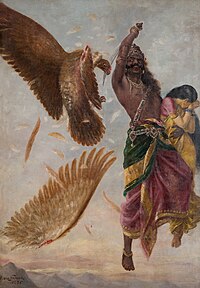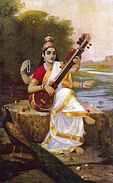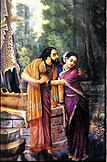There is a difference between making money for oneself and creating wealth for others. This is the story of a business house that has created wealth for a nation. It is a story of struggle, anxiety, adventure and achievement. This is the story of our pioneers.
 Jamsetji Tata: The Founder of the Tata group began with a textile mill in central India in the 1870s. His powerful vision inspired the steel and power industries in India, set the foundation for technical educaton, and helped the country leapfrog from backwardness to the ranks of industrialised nations.
Jamsetji Tata: The Founder of the Tata group began with a textile mill in central India in the 1870s. His powerful vision inspired the steel and power industries in India, set the foundation for technical educaton, and helped the country leapfrog from backwardness to the ranks of industrialised nations.
- The giant who touched tomorrow: A profile
- Standing tall: A tribute by historian Dwijendra Tripathi
- Values are forever: Tata Sons director R Gopalakrishnan on Jamsetji Tata’s unique legacy
- A man in full: Excerpts from the biography by Frank Harris
- The quotable Jamsetji Tata: Quotes by and about the Tata Founder
- A life in pictures: An interactive album
 Sir Dorab Tata: Through his endeavours in setting up Tata Steel and Tata Power, this elder son of Jamsetji Tata was instrumental in transforming his father's grand vision into reality. It was also under his leadership that the Sir Dorabji Tata Trust, the premier charitable endowment of the Tatas, was created, propelling the Tata tradition of philanthropy.
Sir Dorab Tata: Through his endeavours in setting up Tata Steel and Tata Power, this elder son of Jamsetji Tata was instrumental in transforming his father's grand vision into reality. It was also under his leadership that the Sir Dorabji Tata Trust, the premier charitable endowment of the Tatas, was created, propelling the Tata tradition of philanthropy.
 Sir Ratan Tata: Jamsetji Tata's younger son had a personality that reflected his sensitivity to the struggles of ordinary people and his desire to utilise his considerable wealth to enhance the quality of public life. A philanthropist all his life, he created a trust fund for "the advancement of learning and for the relief of human suffering and other works of public utility." The Sir Ratan Tata Trust is today the second largest of the Tata trusts.
Sir Ratan Tata: Jamsetji Tata's younger son had a personality that reflected his sensitivity to the struggles of ordinary people and his desire to utilise his considerable wealth to enhance the quality of public life. A philanthropist all his life, he created a trust fund for "the advancement of learning and for the relief of human suffering and other works of public utility." The Sir Ratan Tata Trust is today the second largest of the Tata trusts.
 JRD Tata: The late chairman of the Tata Group pioneered civil aviation on the subcontinent in 1932 by launching the airline now known as Air India. That was the first of many path-breaking achievements that JRD, who guided the destiny of the Group for more than half a century, came to be remembered for.
JRD Tata: The late chairman of the Tata Group pioneered civil aviation on the subcontinent in 1932 by launching the airline now known as Air India. That was the first of many path-breaking achievements that JRD, who guided the destiny of the Group for more than half a century, came to be remembered for.
- Spirit of the skies: A profile
- From here to eternity: Keshub Mahindra, the patriarch of the Mahindra & Mahindra Group, remembers ‘Jeh’
- Appro JRD: Sudha Murthy recalls an incident that shaped her life
- One of a kind: Long-time associate Maneck Dalal on a multifaceted personality
- A legend lives on: Ratan Tata pays tribute to the leader he succeeded
- The JRD I knew: JJ Bhabha remembers JRD’s contributions
- JRD, the eternal icon: Tata veteran TR Doongaji on the shaping of a legend
- The man behind the icon: SA Sabavala recalls a leader of many passions
- Wings for a nation: Excerpts from RM Lala’s The Creation of Wealth
- A life in pictures: An interactive album
 Naval Tata: Naval Tata's many contributions in the fields of business, sports administration and labour relations symbolised all that is best in the Tata spirit of giving back to society and the communities in which its enterprises grow.
Naval Tata: Naval Tata's many contributions in the fields of business, sports administration and labour relations symbolised all that is best in the Tata spirit of giving back to society and the communities in which its enterprises grow.
- A life lived from the heart: A profile
- Keeper of the flame: Simone Tata, Naval Tata’s wife, on a kind and humane spirit
- My friend Naval: Business leader Ram S Tarneja on a man who thought beyond profits
- An August requiem: JK Setna remembers a gentleman and a friend
- A life in pictures: An interactive album
- Quotes by and about Naval Tata
Born In: Navsari, Gujarat, India
Died On: May 19, 1904
Occupation: Industrialist, Entrepreneur
Nationality: Indian
Whenever we think of the name Jamsetji Tata, we think of the expansive Tata Group of companies which continue to rule the industrial world of India till today. Jamsetji Tata founded the vast industrial empire that has received an identity today all over the world. Jamsetji Tata belonged to a trading family and business ran in his blood, therefore it was quite natural that he chose to be a businessman very early in his life. However, little did anybody know that Jamsetji Tata would be successful in redefining the concept of industries in India and would be listed in the pages of history as the 'Father of Indian Industry'!
Early Life
Born as Jamsetji Nusserwanji Tata on March 3, 1839, Jamsetji Tata was the son of Nusserwanji Tata, the only businessman in a Parsi family that earned its living as Zoroastrian priests. Along with his wife Jeevanbai Tata, Nusserwanji Tata had moved out of his family to carry on his passion of business in Bombay. Nusserwanji Tata started off as a small trader, but nevertheless did quite well. Jamsetji Tata completed his graduation at Elphinstone College in Bombay, where he was known as such a bright student that the principal decided to refund Jamsetji Tata's fees once he completed his degree. Jamsetji Tata took up trading at a very early age of 14, a time when he was still studying. Since child marriage was practiced during those days, the future business tycoon got married at the tender age of sixteen to the ten year old Hirabai Daboo.
He graduated from college in 1858 and joined his father's trading firm. It was a turbulent time to step into business as the Indian Rebellion of 1857 had just been suppressed by the British government.
Career As A Businessman
Though Jamestji Tata started off working ever since he was 14, his real contribution came only after he had graduated in 1858. He became actively involved in his father's export business at a time when the business scenario in India was far from prosperous, largely because of the Sepoy Mutiny of 1857, which had been suppressed by the British Raj and had taken India by storm. Nevertheless, Nusserwanji Tata sent his son on a trip to Hong Kong in 1859 to expand his business interests there, a work that Jamsetji Tata completed successfully. Jamsetji Tata remained in Hong Kong for the next four years, trying to fulfill and realize his father's dream of setting up a branch of the Tata & Co. office there. The establishment of the new Tata & Co. office in Hong Kong was the beginning of the expansion of the Tata empire throughout Asia and the first step towards the creation of Tata & Sons.
By the year 1863, there were Tata offices not only in Hong Kong, but also in Japan and China. Following the huge business success in Asia, Jamsetji Tata now traveled to Europe, but unlike in Asia, he faced with a drawback in the initial stages. Part of Jamsetji Tata's aims in visiting England, apart from increasing the number of contacts for his father's export business based in India, was to establish an Indian Bank in London. This project, however, proved highly unsuccessful for the Tatas because it was not a favorable time for the banking sector, with a financial crisis hitting the markets in several parts of India. The Tata companies in India and all over Asia faced huge monetary loss after the failure of the establishment of the Indian bank.
Later Stages of Career
Jamsetji Tata worked with his father until the age of 29, after which he started a trading company of his own. This was in the year 1868, following which Jamsetji Tata gradually acquired and established several cotton mills of his own. The Empress Mill set up in Nagpur in 1874 brought Jamsetji Tata huge amounts of money. The name of the mill was so inspired after Queen Victoria became the Empress Of India. The mills made large amounts of profit, but were thereafter sold off by Jamsetji Tata for a higher sum of money. Jamsetji Tata's cotton mills produced cloth which were used in India and also exported to countries of Japan, Korea, China and several parts of the Middle East. The mills were largely established to satisfy Jamsetji Tata's business acumen, but it may be recalled that the Dharamsi cotton mill which was later renamed to Swadeshi cotton mill kept the nationalistic sentiment in mind and made use of only Indian products, particularly promoting the non-use of British raw material.
Just like it is today, even in the pre-independent era, Jamsetji Tata made it a point to look after the best interests of the workers in Tata & Sons. The Tata companies were then also known to provide the best working atmosphere for its workers. Policies which were unheard of during those times, like medical facilities for the sick and for women with children, provision of pensions, accident compensations and on the job training, were a part of the companies owned by Jamsetji Tata. It was Jamsetji Tata who appealed to the Japanese Steam Navigation Company to reduce freight charges, a factor which was largely diminishing his profits. Though it was for the benefit for the entire nation, Jamsetji Tata made it a point to spend his own money to get the case solved when his demands led to huge upheavals in Japan. Eventually, Jamsetji Tata did emerge successful in reducing freight charges and thereby increasing profits for Indian traders.
Business Legacy
The cotton mills did satisfy his business acumen, but to remain stuck on the production of cloth was not the aim of Jamsetji Tata. His vision was to establish an iron and steel plant, a world class hotel, a learning institution and a hydro electric power project. Among his four wishes, only the second was fulfilled during Jamsetji Tata's lifetime when the Taj Mahal Hotel was established on December 3, 1903. In 1901, Jamsetji Tata traveled to Europe and America to educate himself on the making of steel. In addition, he made it a point to educate himself on the latest technological progress that had taken place over the years all around the world so that he may use it for the betterment of the industries under Tata & Sons. Sadly, Jamsetji Tata could not stay alive to realize his dream of establishing an iron and steel plant in India.
Death
Jamsetji Tata breathed his last on May 19, 1904. He was the sole inspiration behind a group that today is one of the biggest industries of not only India but of the world also.
Legacy
Post Jamshetji Tata's death, The Tata Group was succeeded by his two sons, Dorabji Tata and Ratanji Tata. One of the most affluent, prosperous and well-to-do organizations, the Tata Group is today amongst the largest and most respected companies of the world. A pioneer of his field, the vision and aim of Jamsetji Tata came to life with time as his family gave wings to each of his dream projects. In fact, such was his contribution that the city of Jamshedpur in Jhakhand is today popularly known as Tatanagar, because of the many facilities that the group has endowed the city with. Today, the group boasts of being the founder of projects like Tata Steel, the Indian Institute of Science, the Tata Power Company Limited, the Taj Mahal Palace & Tower, the Tata Institute of Fundamental Research and many more.
Timeline
1839: Jamsetji Tata was born on March 3.
1853: He married Hirabai Daboo.
1858: Joined his father's trade firm.
1868: Established his first independent company.
1874: Set up the Empress Mill.
1901: Traveled to Europe and America to receive education on making of steel.
1903: Established the Taj Mahal Hotel.
1904: Died on May 19.
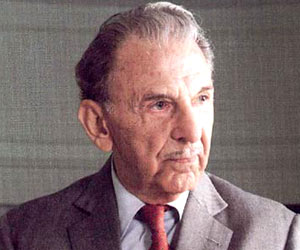
Died: on November 29, 1993
Achievements: He had the honor of being India's first pilot; was Chairman of Tata & Sons for 50 years; launched Air India International as India's first international airline; received Bharat Ratna in 1992.
JRD Tata was one of the most enterprising Indian entrepreneurs. He was a pioneer aviator and built one of the largest industrial houses of India.
JRD Tata was born on July 29, 1904 in Paris. His mother was a French, while his father was Parsi. JRD's full name was Jehangir Ratanji Dadabhoy Tata and he was popularly known as Jeh to his friends. JRD's father Ratanji Dadabhoy Tata and Sri Jamsetji Tata shared their greatness from the same great-great-grandfather, Ervad Jamsheed Tata, a priest of Navsari.
JRD Tata was the second of four children. He was educated in France, Japan and England before being drafted into the French army for a mandatory one-year period. JRD wanted to extend his service in the forces but destiny had something else in store for him. By leaving the French army JRD's life was saved because shortly thereafter, the regiment in which he served was totally wiped out during an expedition in Morocco.
JRD Tata joined Tata & Sons as an unpaid apprentice in 1925. He has great interest in flying. On February 10, 1929, JRD became the first Indian to pass the pilot's examination. With this distinctive honor of being India's first pilot, he was instrumental in giving wings to India by building Tata Airlines, which ultimately became Air India. His passion for flying was fulfilled with the formation of the Tata Aviation Service in 1932.
In 1938, at the age of 34, JRD was elected Chairman of Tata & Sons making him the head of the largest industrial group in India. He started with 14 enterprises under his leadership and half a century later on July 26, 1988, when he left , Tata & Sons was a conglomerate of 95 enterprises which they either started or in which they had controlling interest.
JRD was the trustee of Sir Dorabji Tata Trust from its inception in 1932, which remained under his wings for over half a century. Under his guidance, this Trust established Asia's first cancer hospital, the Tata Memorial Center for Cancer, Research and Treatment, Bombay, 1941. It also founded the Tata Institute of Social Sciences, 1936 (TISS), the Tata Institute of Fundamental Research, 1945 (TIFR), and the National Center for Performing Arts.
In 1948, JRD Tata launched Air India International as India's first international airline. In 1953, the Indian Government appointed JRD as Chairman of Air-India and a director on the Board of Indian Airlines-a position JRD retained for 25-years. For his crowning achievements in Aviation, JRD was bestowed with the title of Honorary Air Commodore of India.
In 1956, JRD Tata initiated a program of closer "employee association with management" to give workers a stronger voice in the affairs of the company. He firmly believed in employee welfare and espoused the principles of an eight-hour working day, free medical aid, workers' provident scheme, and workmen's accident compensation schemes, which were later, adopted as statutory requirements in India.
JRD Tata cared greatly for his workers. In 1979, Tata Steel instituted a new practice; a worker is deemed to be "at work" from the moment he leaves home for work till he returns home from work. The company is financially liable to the worker if any mishap takes place on the way to and from work. Tata Steel Township was also selected as a UN Global Compact City because of the quality of life, conditions of sanitation, roads and welfare that were offered by Tata Steel.
JRD Tata received a number of awards. He received the Padma Vibhushan in 1957 on the eve of silver jubilee of Air India. He also received the Guggenheim Medal for aviation in 1988. In 1992, because of his selfless humanitarian endeavors, JRD Tata was awarded India's highest civilian honor, the Bharat Ratna-one of the rarest instances in which this award was granted during a person's lifetime. In the same year, JRD Tata was also bestowed with the United Nations Population Award for his crusading endeavors towards initiating and successfully implementing the family planning movement in India, much before it became an official government policy.
JRD Tata died in Geneva, Switzerland on November 29, 1993 at the age of 89. On his death, the Indian Parliament was adjourned in his memory-an honor not usually given to persons who are not Members of Parliament.
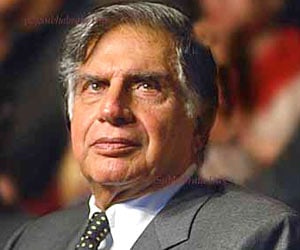
Achievement: Honored with Padma Bhushan, one of the highest civilian awards in 2000.
Ratan Tata is presently the Chairman of Tata Sons, the holding company of the Tata Group. Ratan Naval Tata is also the Chairman of the major Tata companies such as Tata Steel, Tata Motors, Tata Power, Tata Consultancy Services, Tata Tea, Tata Chemicals, Indian Hotels and Tata Teleservices. He has taken Tata Group to new heights and under his leadership Group's revenues have grown manifold.
Ratan Tata was born on December 28, 1937, in Bombay. He received a Bachelor of Science degree in architecture from Cornell University in 1962. Ratan Tata had a short stint with Jones and Emmons in Los Angeles, California, before returning to India in late 1962. He joined the Tata Group and was assigned to various companies before being appointed director-in-charge of The National Radio & Electronics Company (NELCO) in 1971. Ratan Tata was appointed Chairman of Tata Industries in 1981. He was assigned the task of transforming the company into a Group strategy think-tank, and a promoter of new ventures in high technology businesses.
In 1991, Ratan Tata took over the Chairmanship from JRD Tata. Under him Tata Consultancy Services went public and Tata Motors was listed in the New York Stock Exchange. In 1998, Tata Motors came up with Tata Indica, the first truly Indian car. The car was the brainchild of Ratan Tata.
Ratan Tata was honored with Padma Bhushan, one of the highest civilian awards in 2000. He was also conferred an honorary doctorate in business administration by Ohio State University, an honorary doctorate in technology by the Asian Institute of Technology, Bangkok, and an honorary doctorate in science by the University of Warwick.




